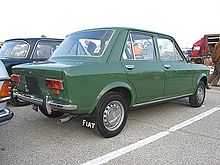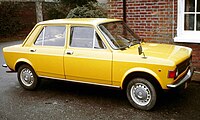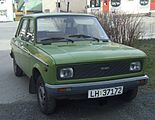Fiat 128
| Fiat | |
|---|---|
|
Fiat 128 (1969-1972)
|
|
| 128 | |
| Production period: | 1969-1983 |
| Class : | Compact class |
| Body versions : | Sedan , station wagon , coupe , Combi Coupé |
| Engines: |
Petrol engines : 1.1–1.3 liters (33–55 kW) |
| Length: | 3850 mm |
| Width: | 1590 mm |
| Height: | 1340 mm |
| Wheelbase : | 2445 mm |
| Empty weight : | 750-770 kg |
| Previous model | Fiat 1100 |
| successor | Fiat Ritmo |
The Fiat 128 is a passenger car from Fiat that the Italian manufacturer built from spring 1969 to the end of 1983.
Model history
General
The Fiat 128 replaced the Fiat 1100 . It was completely redesigned along with a new engine and was the last model developed under the direction of Dante Giacosa . The lead engineer was Aurelio Lampredi, who came to Fiat from Ferrari . With front-wheel drive , transversely installed front engine with overhead camshaft and individually suspended wheels, it was the most modern vehicle on the market at the time.
The engine had a displacement of 1116 cm³ and made 55 HP (40 kW) at 6000 rpm, the overhead camshaft was driven by a toothed belt and operated the parallel hanging valves with bucket tappets . With a piston stroke of just 55 millimeters, the engine was designed to be extremely short-stroke and accordingly easy to turn and lively. The inlet and outlet ports were on the same side of the cylinder head, and the engine was installed in the vehicle at a slight forward tilt. The wheels were suspended at the front on MacPherson struts and wishbones with rack and pinion steering , at the rear on damper legs and trapezoidal wishbones with a transverse leaf spring mounted at two points, which also acted as a stabilizer. The chassis of the 128 was the template for many other vehicles (Autobianchi A112, Fiat 127, Ritmo, Regata, Elba; Seat Ibiza, Yugo Koral and others)
technology
The 128 offered a number of technical solutions that had not yet existed in mass production vehicles:
- It was an everyday vehicle with an overhead camshaft. Lampredi had come up with a new solution for adjusting the valve clearance: the spacer plates for adjusting the clearance were no longer between the bucket tappets and the valve stem, but were inserted into the bucket tappets from above. This meant that the camshaft no longer had to be removed to adjust the clearance, which reduced maintenance costs. The cylinder head was in two parts, a lower cast part carried the wedge-shaped combustion chamber, the gas ducts and the valves, a separate housing the tunneled camshaft. Lampredi had taken all of these design features from its DOHC four-cylinder from the Fiat 124/125 at the time and the V6 engine from the Fiat 130, also designed by Lampredi.
- The belt tension of the toothed belt for driving the camshaft could be adjusted quickly and inexpensively with a tensioning roller. In the first engine with a toothed belt, that of the Glas 1004 , the cylinder head had to be dismantled and spacer plates inserted to tension the belt.
- The transversely installed engine was in alignment with the gearbox, as has since become generally accepted. The concept was introduced shortly after the Second World War (DKW, Saab, Lloyd), but only for two-cylinder engines. Dante Giacosa invented drive shafts of unequal length for the Autobianchi Primula (1964), so that four-cylinder engines could also be used.
- The independent suspension with struts and shock absorbers provided good road holding with a high level of comfort at a time when most competitors had either driven rigid rear axles or pendulum axles.
The car was approximately 3.85 m long and offered a large interior space in relation to the external dimensions. Its driving performance exceeded that of its competitors such as the VW Beetle , Opel Kadett or Ford Escort . Thanks to its technical advantages and its low price, sales in Germany were good at the beginning of the 1970s. However, the technically advanced Fiat models of that time were considered susceptible to rust.
Models
The 128 was initially only available as a two- and four-door notchback sedan, followed by the Familiare station wagon version at the beginning of 1970 (model name "Panorama" from 1976). In the 1970s, the product range was expanded rapidly: with the 128 Rally with 1290 cm³ and 67 hp (49 kW). The development of the larger engine is due to the requirements of motorsport. Fiat used the 128 from the very beginning in rallying, which was extremely popular in Italy at the time, where it competed in the class up to 1150 cm³. In order to compete in the class up to 1300 cm³, the displacement had to be increased. For the version called 128 Rally, a 1290 cm³ version was developed, which was extremely successful in Italian motorsport. From autumn 1972 there was the 128 Sport Coupé (type 128 LS, without tailgate) with 1116 cm³ and 63 hp or 1290 cm³ and 75 hp, replaced from the beginning of 1975 by the 128 Berlinetta as a station wagon with 1100 or 1300 cm³ and the X1 / 9 as a roadster with a mid-engine , 1300 cc and 75 hp. For some countries there was a lower compression 1100 cc engine from 1976 (with the label: Benzina normal), which then made 45 hp and was content with normal gasoline.
Facelift
In the autumn of 1972 the 128 was slightly revised. The chrome rim around the black plastic grille was omitted. In addition, the bumpers got narrow rubber strips and the bumper horns fell away.
Another revision in the spring of 1976 brought redesigned rear lights and plastic panels instead of the chrome trim, also on the front and rear bumpers. In the interior was u. a. the dashboard again.
In April 1978 the successor model Fiat Ritmo was presented. Due to the continuing demand, the Fiat 128 was produced in parallel to the Ritmo until the end of 1983.
The 128 abroad
Zastava in Kragujevac, ( Yugoslavia , later Serbia ) built a variant of the model for decades as a hatchback sedan, first under the name Zastava 101 and later as the Zastava Skala . From the 1980s, the notchback version of the Fiat 128 was also manufactured by Zastava. In 2008 production was stopped. In Yugoslavia and South Africa there was also a pick-up version of the 128 . In Zambia, the 128 was assembled at Livingstone Motor Assemblers .
In Argentina it was first built as Fiat Europa and from 1983 to 1990 in a heavily modernized variant as Fiat Súper Europa .
A notchback version of the model also rolled off the assembly line at El Nasr Automotive Manufacturing Company in Egypt by 2009 . They had marketed it as the Nasr 128 GLS 1300 .
| Technical data Fiat 128 | |||||||
|---|---|---|---|---|---|---|---|
| Fiat 128: | Limousine 1100 | Sport Coupe 1100 | Limousine USA | Sedan 1300 USA | Rally | Sport Coupé 1300 | Sport Coupe USA |
| engine | 4-cylinder in-line engine (four-stroke) | ||||||
| Displacement | 1116 cc | 1290 cc | |||||
| Bore × stroke | 80 x 55.5 mm | 86 × 55.5 mm | |||||
| Power at 1 / min | 40 kW (55 PS) at 6000 |
47 kW (64 PS) at 6000 |
37 kW (50 PS) at 6000 |
46 kW (63 hp) at 6000 |
49 kW (67 hp) at 6400 |
55 kW (75 PS) at 6600 |
46 kW (63 hp) at 6000 |
| Max. Torque at 1 / min | 81 Nm at 3200 | 86 Nm at 4400 | 68 Nm at 3600 | 91 Nm at 4000 | 92 Nm at 4000 | 86 Nm at 4400 | 91 Nm at 4000 |
| compression | 8.8: 1 | 8.5: 1 | 8.9: 1 | 8.5: 1 | |||
| Mixture preparation | 1 Weber or Holley 32 downdraft carburettor | 1 double carburetor Weber 32 | 1 Weber 32 carburetor | 1 double carburetor | 1 double carburetor Weber 32 | ||
| Valve control | OHC , timing belt | ||||||
| cooling | Water cooling | ||||||
| transmission | 4-speed gearbox, center shift, front-wheel drive | ||||||
| Front suspension | Suspension strut axle, lower wishbones, coil springs | ||||||
| Rear suspension | Wishbones, shock absorber struts, transverse leaf spring | ||||||
| Brakes | Front disc brakes (diameter 22.7 cm), rear drum brakes, brake booster | ||||||
| steering | Rack and pinion steering | ||||||
| body | Sheet steel, self-supporting | ||||||
| Front / rear track | Lim .: 1310/1315 mm Sport Coupé: 1325/1335 mm |
||||||
| wheelbase | Lim .: 2450 mm Sport Coupé: 2225 mm |
||||||
| Dimensions | Lim .: 3840 (USA 4028) × 1590 × 1420 mm Sport Coupé: 3810 (USA 3973) × 1560 × 1310 mm |
||||||
| Empty weight | 785-825 kg | 810-815 kg | 797-831 kg | 856-899 kg | 820 kg | 815-820 kg | 897 kg |
| Top speed | 135-140 km / h | 150+ km / h | not specified | 150 km / h | 160 km / h | not specified | |
| 0-100 km / h | 19.1-20.5 s | 15.5 s | not specified | 13.5 s | not specified | ||
| Consumption (liters / 100 kilometers, CUNA norm) | 8.0 S. | 8-12 pp | not specified | 9-12 pp | not specified | ||
| Price (DM, 1973) (US $) |
6,620-7,120 | 7,990-8,490 | - 2,195 (1973) |
- 3,445 (1979) |
7,440 | 8,390-8,990 | - 2,795 (1973) |
Web links
- Community of Fiat 128 Friends The "Community of Fiat 128 Friends 1992 eV" takes care of the preservation of the rare models
- Scuderia Fiat 128 Web link to Scuderia Fiat 128, a non-commercial and independent community of fans
Individual evidence
- ^ End of Yugo, Florida and Skala , accessed March 20, 2010
literature
- Automobil Revue , catalog numbers 1969, 1973 (technical data and prices)
- Mike Covello: Standard Catalog of Imported Cars 1946-2002 . Krause Publications, Iola (USA) 2002, ISBN 0-87341-605-8 , pp. 306-310.
- Carlo Alberto Gabellieri, Francesco Panarotto: "Fiat 128: la Storia, le Corse, le Vittorie". Edizioni SileaGrafiche, Italy 2005









